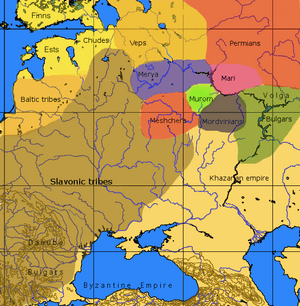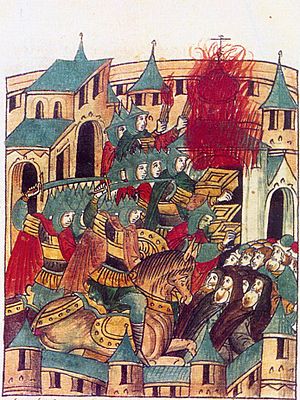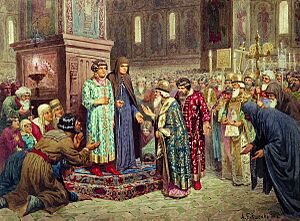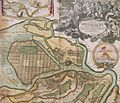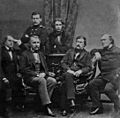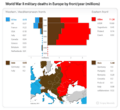History of Russia facts for kids
The history of Russia is a long and exciting story. It started with different groups like the East Slavs, Turkic, and Finno-Ugric peoples. Early on, parts of Southern Russia near the Black Sea were home to Greeks and Romans. Later, tribes like the Huns and other Turkic groups moved into these areas.
Eastern Slavs then settled in the region. Vikings helped create the first major state, called Kievan Rus'. In the 1200s, Mongols took over and formed the Golden Horde. They ruled for about 200 years. After the Mongols, the Tsardom of Russia and later the Russian Empire grew powerful. Russia expanded its lands, reaching far into Siberia.
Famous leaders like Napoleon and Hitler tried to invade Russia but failed. Russia fought in World War I. In 1917, the October Revolution led to the creation of the Soviet Union by communists. After World War II, the Soviet Union became a big rival of the United States during the Cold War. In the 1990s, the Soviet Union ended, and modern Russia was formed. In 2014, Russia took Crimea from Ukraine, which led to sanctions from other countries.
Contents
- Early History: Greeks, Romans, and Huns (Before 3rd Century)
- Turkic Peoples and the Khazars (3rd to 10th Century)
- Eastern Slavs and Kievan Rus' (7th to 13th Century)
- Mongol Rule: The Golden Horde (13th to 15th Century)
- Tsardom of Russia (1547–1721)
- Russian Empire (1721–1917)
- Russian Revolution (1917–1922)
- Related pages
- Images for kids
- See also
Early History: Greeks, Romans, and Huns (Before 3rd Century)
Long ago, around 800 BCE, Greek traders came to places like Tanais in Southern Russia. A Greek kingdom called the Bosporan Kingdom later became part of the Roman Empire.
Around 200 CE, Germanic Goths moved to the Black Sea area. In the 3rd and 4th centuries, the Goths had a kingdom in Southern Russia. But then the Huns conquered it.
Turkic Peoples and the Khazars (3rd to 10th Century)
Between the 3rd and 6th centuries, the Bosporan Kingdom was also invaded by groups like the Huns and Turkish Avars.
A Turkic group called the Khazars took control of the lower Volga River area. This was between the Caspian Sea and the Black Sea until the 8th century. The Khazars were known for their fair laws and tolerance. They traded with people from the Baltic Sea and the Muslim Abbasid Caliphate in Baghdad. They were also important friends of the Byzantine Empire. They helped the Byzantines fight against Arab empires. In the 8th century, many Khazars became Jewish.
Eastern Slavs and Kievan Rus' (7th to 13th Century)
The ancestors of modern Russians were the Slavic tribes. They came from the Pripet Marshes. Early East Slavs slowly settled Western Russia. They moved from Kiev towards Suzdal and Murom. Then they went from Polotsk towards Novgorod and Rostov.
From the 7th century, East Slavs became the main group in Western Russia. They slowly mixed with native Finno-Ugric tribes. These included the Merya, Muromians, and Meshchera.
The Cyrillic alphabet also spread during this time. It was invented in modern Bulgaria in the 9th century.
Kievan Rus': The First Russian State (882–1283)
Vikings, also called Varangians, were traders and pirates. In the mid-9th century, they took control of lands from the eastern Baltic Sea to the Black Sea and Caspian Sea. A Varangian named Rurik became the ruler of Novgorod around 860. Later, they moved south and conquered Kiev. Kiev had been controlled by the Turkic Khazars.
Rurik's son Igor and his grandson Sviatoslav conquered East Slavic tribes. They also defeated the Khazar kingdom. They even fought wars against the Byzantine Empire and Persia.
This is how Kievan Rus' began in the 9th century. It was located along the Dnieper River. Kievan Rus' controlled trade for furs, wax, and slaves. This trade route connected Scandinavia with the Byzantine Empire.
Around the 11th century, the Norse rulers mixed with the Eastern Slavs. The Slavs adopted Greek Christian ideas. This happened when they tried to raid Constantinople. Svyatoslav I defeated the Khazars on the Volga River. The Byzantine Empire was getting weaker. But it still had a big cultural impact on Russia.
For example, the Kievan Rus' adopted the Eastern Orthodox form of Christianity from the Byzantines. They became Christian in 988.
Later, Yaroslav the Wise created some important laws. By the 11th century, he also helped improve the economy and literature. The Russian language was not much changed by Greek or Latin. Church Slavonic was used directly in church services.
A nomadic Turkic group, the Kipchaks (or Cumans), replaced earlier Pechenegs in the southern steppe. They formed a nomadic state along the Black Sea. The Kipchaks and Kievan Rus' often fought.
Mongol Rule: The Golden Horde (13th to 15th Century)
In the 13th century, the Mongols of the Golden Horde conquered the Rus' lands. Kiev was destroyed. Some parts, like Halych-Volhynia, later joined the Polish-Lithuanian Commonwealth. Other parts, like Vladimir-Suzdal and the independent Novgorod Republic, became the foundation for modern Russia.
In 1223, the Russian princes fought a Mongol raiding party at the Kalka River. They were badly defeated. In 1237–1238, the Mongols burned down Vladimir and other major cities in northeast Russia. They defeated the Russians at the Sit' River. Then they moved west to conquer Poland and Hungary. By this time, they had conquered most of Russia.
The Mongols destroyed many cities. Some, like Kiev and Vladimir, never fully recovered. New cities like Moscow, Tver, and Nizhny Novgorod began to grow. They competed for power in Mongol-controlled Russia. The Golden Horde was established in the 14th century. Mongol rule over Russia, including demands for payments from Russian princes, lasted until about 1480.
Russia and the Tatars
After the Turkic Khazars fell in the 10th century, the Volga region was conquered by Volga Bulgaria. This group became Muslim in the 10th century. They traded with the Middle East and Central Asia. After the Mongol invasions in the 1230s, Volga Bulgaria was added to the Golden Horde. Its people became the modern Chuvashes and Kazan Tatars.
The Mongols controlled Russia and Volga Bulgaria from their capital at Sarai. Russian princes had to pay tribute to the Mongols, who were often called Tatars. The Russian Orthodox Church even saw a revival during this time.
The Mongols influenced Russian military tactics and transportation. Under Mongol rule, Russia developed its postal system, a way to count people (census), a tax system, and military organization.
Rise of Moscow (1283–1547)
Daniil Aleksandrovich founded Moscow (Muscovy). At first, Moscow was a small state that paid tribute to the Mongols and Tatars.
The Mongol rulers gave Moscow's princes the title of Grand Prince. They made them collect tribute from other Russian areas. Moscow also became the center of the Russian Orthodox Church.
Ivan III, the Great
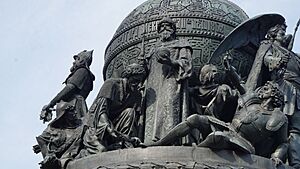
In the 15th century, the princes of Moscow continued to unite Russian lands. This helped them increase their population and wealth. The most successful was Ivan III, also known as Ivan the Great. He laid the groundwork for the Russian nation. Ivan competed with the Grand Duchy of Lithuania for control over important river basins.
Ivan III was able to add Novgorod and Tver to his lands. As a result, the Grand Duchy of Moscow tripled in size.
Ivan then ended the rule of the Tatars and the Golden Horde. The Golden Horde had split into several smaller groups. Ivan wanted to protect Russia's southern borders from the Crimean Tatars. He built a large defensive line called the Great Abatis Belt. He also gave land to nobles in exchange for military service. This helped expand his army.
Eventually, Ivan IV became the first Russian ruler to call himself tsar.
Ivan III tripled his state's territory. He ended the Golden Horde's control over Russia. He also rebuilt the Moscow Kremlin. However, he was against the Catholic Church. This made Russia more isolated from western civilization.
Tsardom of Russia (1547–1721)
Ivan IV the Terrible

"Ivan the Terrible" greatly increased the power of the tsar. He was known for being harsh and removing people he disliked. But he also helped Russia grow and introduced new laws. He also reduced the church's influence.
Ivan added the Khanates of Kazan, Astrakhan, and Siberia to Russia. This meant Russia now had Muslim Tatar populations. It became a state with many different ethnic groups and religions. The Stroganov family also controlled the Ural Mountains. They hired Russian Cossacks to help colonize Siberia.
Ivan divided Russia and created the oprichnina. During this time, Ivan killed many nobles. He also caused the Massacre of Novgorod in 1570. Military losses, disease, and lack of food weakened Russia. The Crimean Tatars were able to raid central Russia and burn down Moscow in 1571. Ivan stopped his harsh rule in 1572.
At the end of Ivan IV's rule, armies from the Polish-Lithuanian Commonwealth and Sweden invaded northwestern Russia.
Time of Troubles
After Ivan IV, Russia faced a difficult period called the "Time of Troubles" (1606–13). There were many civil wars and foreign invasions. Very cold summers from 1601–1603 destroyed crops. This led to a terrible famine and made the chaos even worse.
During the Polish–Muscovite War (1605–1618), Polish–Lithuanian forces invaded Moscow. They put their own rulers in charge.
But Russia finally took back Moscow on November 4, 1612.
Romanov Dynasty
In February 1613, Michael Romanov was chosen as the new ruler. The Romanov dynasty then ruled Russia until 1917.
Russian Empire (1721–1917)
Russia grew a lot during the 17th century. This included the first Russian settlements in the Pacific region. There was also the Russo-Polish War (1654–67). Russia gained most of its new land from conquering Siberia.
Russian Revolution (1917–1922)
The old system of tsars was completely overthrown in February 1917. This led to the October Revolution.
Related pages
Images for kids
-
The Millennium of Russia monument in Veliky Novgorod (unveiled on 8 September 1862)
-
The Kurgan hypothesis: South Russia as the urheimat of Indo-European peoples
-
Stele with two Hellenistic soldiers of the Bosporan Kingdom; from Taman peninsula (Yubileynoe), southern Russia, 3rd quarter of the 4th century BC; marble, Pushkin Museum
-
Arrival of Varangians by Viktor Vasnetsov
-
The Great Stand on the Ugra River (1480), ended Tatar/Mongol rule in Russia.
-
The Poles surrender the Moscow Kremlin to Prince Pozharsky in 1612.
-
Map of the city of Saint-Petersburg, new capital of Russia in 1720
-
Russian victory at Battle of Poltava
-
Mikhail Lomonosov — great Russian polymath, scientist and writer
-
Napoleon's retreat from Moscow
-
The entry of Russian troops into Paris in 1814, headed by the Emperor Alexander I
-
The Decembrists at the Senate Square
-
The eleven-month siege of a Russian naval base at Sevastopol during the Crimean War
-
The manifesto of the abolition of serfdom is being read to people.
-
Russian writers of the second half of the 19th century: Leo Tolstoy, Dmitry Grigorovich, Ivan Goncharov, Ivan Turgenev, Alexander Druzhinin, and Alexander Ostrovsky
-
The October Manifesto granting civil liberties and establishing first parliament
-
Lenin and Stalin at Gorki (1922)
-
Soviet poster from 1932 symbolizing the reform of "old ways of life", dedicated to liberation of women from traditional role of the oppressed housekeeper. The text reads, "8 March is the day of the rebellion of the working women against the kitchen slavery." "Say NO to the oppression and Babbittry of the household work!"
-
The first five Marshals of the Soviet Union in November 1935, clockwise from top left: Semyon Budyonny, Vasily Blyukher, Alexander Ilyich Yegorov, Kliment Voroshilov and Mikhail Tukhachevsky. Only Budyonny and Voroshilov would survive Stalin's Great Purge.
-
World War II military deaths in Europe and military situation in autumn 1944
-
Soviet soldiers during the Battle of Stalingrad, the largest and bloodiest battle in the history of warfare, the turning point on the Eastern Front, in the war against the Axis and in the entire WWII
-
Big Three in Yalta formed U.K. Prime Minister Winston Churchill, U.S. President Franklin D. Roosevelt and the Soviet Leader Joseph Stalin led the Allies against the Axis centered on Nazi Germany.
-
US Army tanks face off against Soviet armor at Checkpoint Charlie, Berlin, October 1961
-
May Day parade in Moscow, 1 May 1964
-
President Jimmy Carter and Soviet General Secretary Leonid Brezhnev sign the Strategic Arms Limitation Talks (SALT II) treaty, 18 June 1979
-
Yuri Gagarin, first human to travel into space
-
Ronald Reagan and Mikhail Gorbachev in Geneva, November 1985
-
Boris Yeltsin—first president of Russian Federation in 1999
-
Vladimir Putin and pro-Russian Crimea leaders sign the Treaty on Accession of the Republic of Crimea to Russia in 2014
See also
 In Spanish: Historia de Rusia para niños
In Spanish: Historia de Rusia para niños


